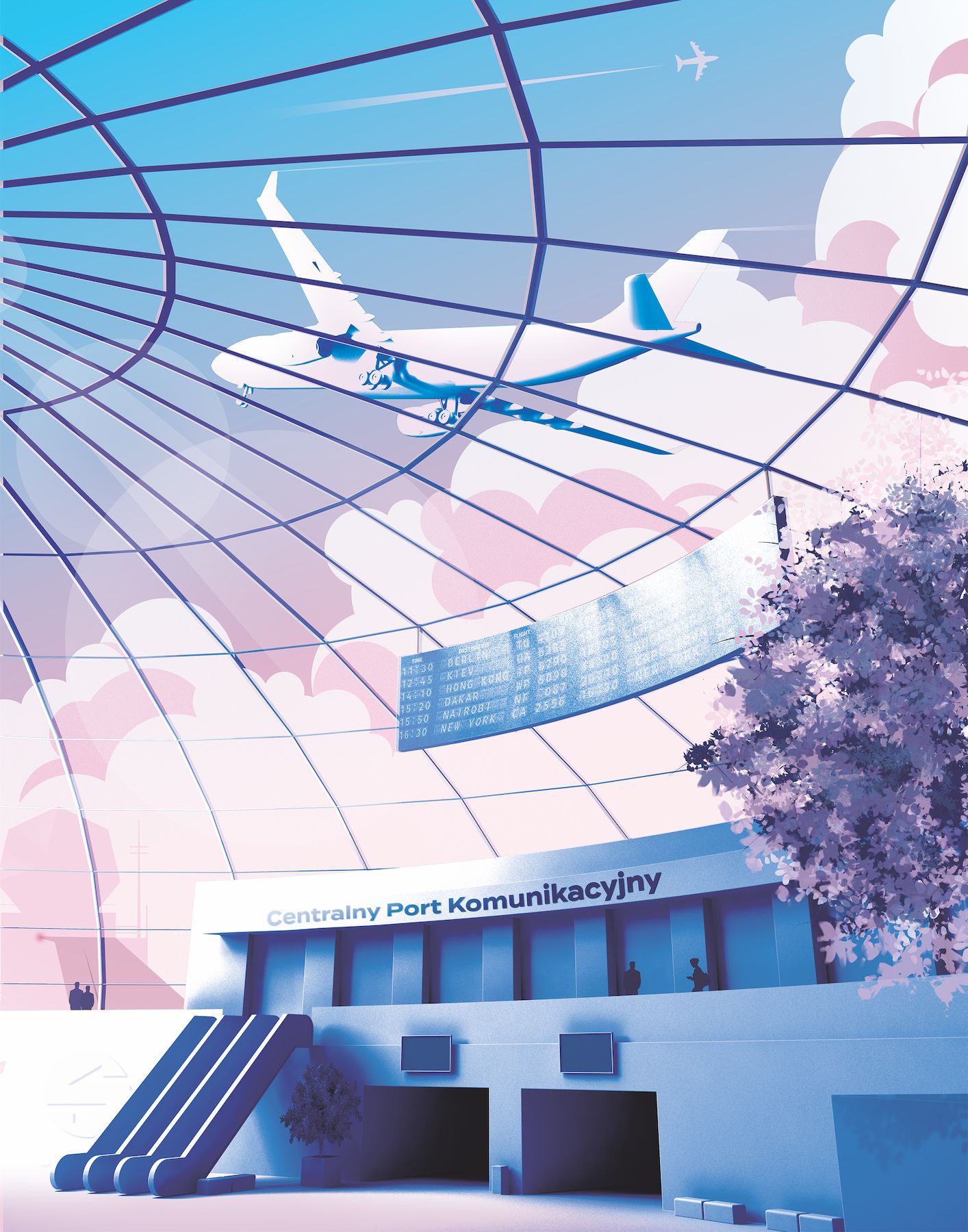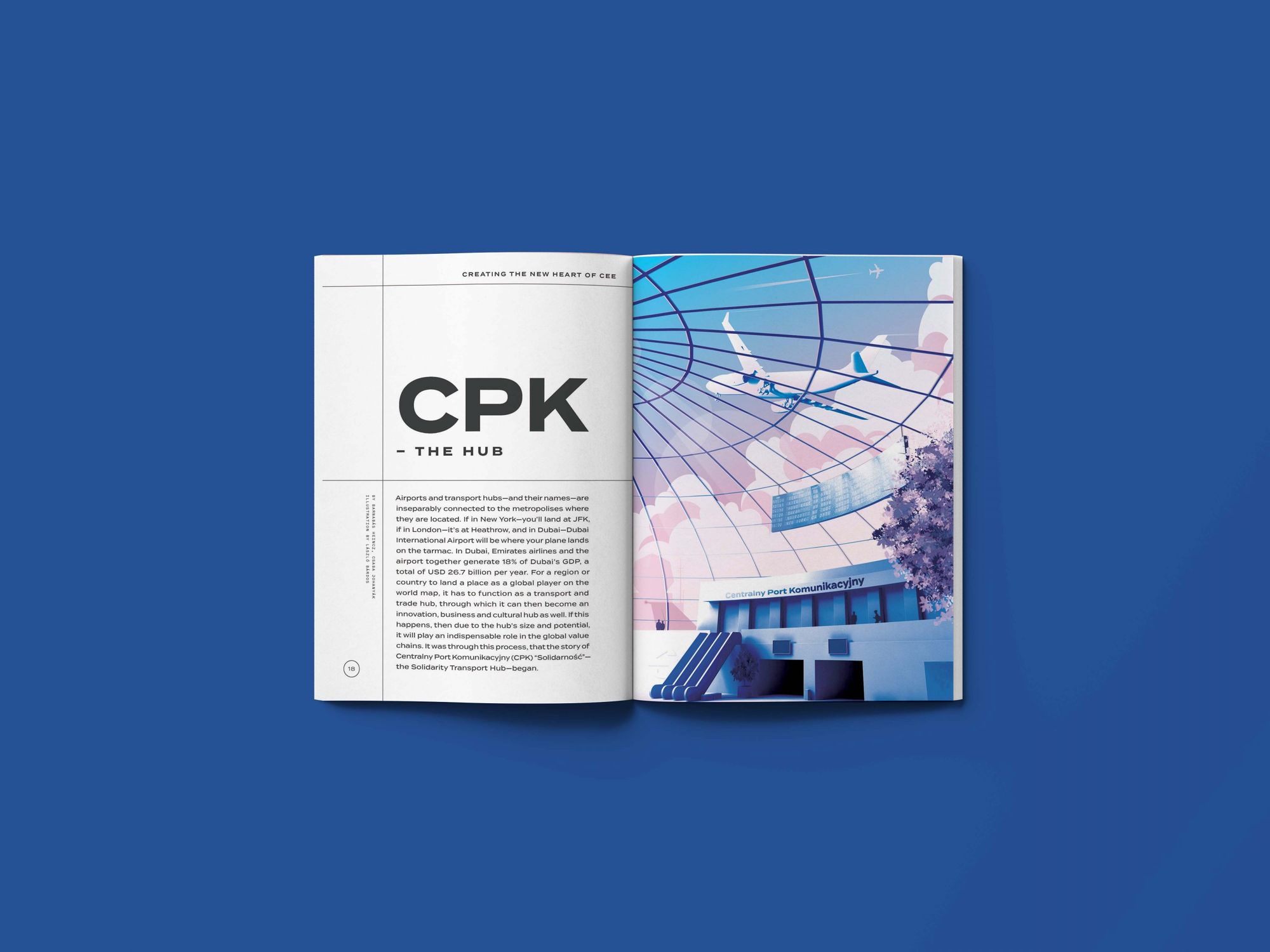Airports and transport hubs—and their names—are inseparably connected to the metropolises where they are located. If in New York—you’ll land at JFK, if in London—it’s at Heathrow, and in Dubai—Dubai International Airport will be where your plane lands on the tarmac. In Dubai, Emirates airlines and the airport together generate 18% of Dubai’s GDP, a total of USD 26.7 billion per year. For a region or country to land a place as a global player on the world map, it has to function as a transport and trade hub, through which it can then become an innovation, business and cultural hub as well. If this happens, then due to the hub’s size and potential, it will play an indispensable role in the global value chains. It was through this process, that the story of Centralny Port Komunikacyjny (CPK) “Solidarność”—the Solidarity Transport Hub—began.
This article was published in print in Hype&Hyper 2022/1.
Authors: Barnabás Heincz, Csaba Johanyák
Illustrations: László Bárdos
In 2017, the Polish government decided to irrevocably put Poland—and with it, Central Europe—on the world map. Under the framework of the CPK megaproject, plans are underway to build a huge airport close to Baranów, 37 kilometers from Warsaw, which is intended to be the center not only for air transport, but for rail and road transport as well. The capital of Poland, Warsaw is also an economic, political, and innovation center, while Łódź is the second-largest Polish city with a huge industrial center and business heritage, CPK would be built between these two metropolises, giving the whole world an opportunity to get to know the most dynamic region of Central Europe.
The CPK mega airport is intended to replace Frederic Chopin Airport, the current airport of Warsaw, and will form an integrated unit with a railway station from which all important cities of Poland, such as Kraków, Wrocław, Poznań, and Gdańsk could be reached in 2.5 hours by express trains. The facility would employ 150.000 people, and plans are to build a whole town to serve CPK, with hotels, conference facilities, and exhibition spaces. The replacement of Frederic Chopin Airport has been widely discussed by the Polish public since 2005, and in the preliminary design tender for the new airport, international big shots like Foster+Partners, Grimshaw, Chapman Taylor, Zaha Hadid Architects, Benoy, and Pascall+Watson submitted their concepts but CPK the only one providing effective and complex answers to infrastructural challenges. The completion of the project is still far in the future, with initial groundwork scheduled to commence in 2023, followed by the actual construction in 2027.

The question arises, how can Poland afford an investment of this scale, particularly during the current unfolding economic recession? From where will Warsaw finance the EUR 2.77 billion needed for their huge dream project? As Rafał Milczarski, the chief executive officer of LOT Polish Airlines explained: during this crisis, it is of utmost importance for the Polish economy to build CPK. The Polish are not the sole financiers of the project, as South Korean companies and the South Korean State also have an interest in the project—as a minority shareholder, providing a share of the cost. As Marcin Horała, the government plenipotentiary for CPK said: “the airport is the joint investment of Poland and South Korea, and it merges South Korean knowledge and experience with Polish ambition and potential”. Besides the South Korean investors, EU funds are also available for the project, as public transport developments help to decrease air pollution, which is a top priority for the EU, and this can be also used to support railway and station development for CPK.
Although the pandemic slowed the progress down, the recovery of the global airline industry may happen much faster than anticipated by experts. Although the figures for the first year need to be amended due to the industry shock of 2020, the intermodal traffic hub would see 40 million passengers in the first year, and this number would soon increase to 140 million. According to some optimistic estimates, the megahub would be able to handle 850 million passengers by 2060, alongside several million tons of air cargo. The latter is very important, as air cargo freight generates more profit than air passenger transport, and also creates a new dimension for the economy thanks to fast and efficient transport. Furthermore, according to some estimates, by the middle of the century, CPK may compete with the largest European airports in air cargo freight.
Even though the construction of the megahub would cost EUR 2.77 billion, it is not merely a money drain. Such an intermodal hub would have an enormous positive effect on the development and economic life of the region, and would mean a huge leap forward for the neighbouring countries. From Budapest, the hub would be accessible in less than an hour by plane, or on a high speed railway line, and would offer railway routes to several cities in Poland, and airplane connections to anywhere on the Earth. From Czechia and Slovakia, CPK would only be a few hours’ drive as well, providing easy access for all the Visegrad countries. The direct effects of the investment are obvious: it would create several thousands of new jobs, be linked to a vast pool of subcontractors, and it would drive investments and consumption, as well as fueling the economy. The tourism and entertainment sectors would also enjoy the immediate benefits, and as an indirect effect, even more business partners could enjoy themselves among the skyscrapers of Warsaw.
As for its effect on the region, it’s important to highlight that due to its good local connections, CPK would open up the previously hidden, small CEE markets. Let’s consider the idea with the following example: currently, two—generally Western European—transit flights are needed to travel from Brazil to Estonia, but CPK would create a whole new dimension of air travel. Now, 90% of long-haul outbound air traffic from Central and Eastern Europe is conducted via a transit airport outside the region, which means the advantages of this traffic is lost. It’s also important to point out that there is a permanent shortage of capacity in Western hubs, however the situation would be entirely different with CPK—it would bring along new markets, new capacities, new opportunities, and a new Central Europe.

Prefer to read it in print? Order the third issue of Hype&Hyper magazine from our online Store!

Winners of Best in Design announced at Zlin Design Week

Bauhaus, Hungarian Neoavantgarde and folk motifs in I O’s new collection










